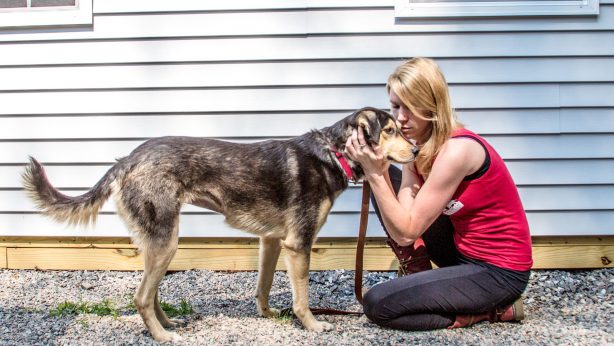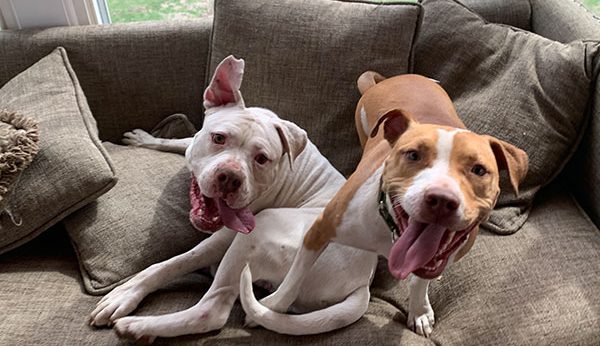Bringing Hope to Dogs Suffering from Separation Anxiety
Bringing Hope to Dogs Suffering from Separation Anxiety:
An interview with Malena De Martini-Price

Imagine if being left alone at home – even for a few moments – left you shaking and wracked with fear? That is the case for the millions of dogs who suffer from some form of separation anxiety. The good news is that this condition is highly treatable. There has been tremendous success with addressing separation anxiety through humane methods such as careful desensitization.
Today we’re honored to have the opportunity to talk with Malena De Martini-Price, a sought-after expert in dog separation anxiety disorders and author of Treating Separation Anxiety in Dogs, who explained how to help dogs with this vexing condition.
What exactly is separation anxiety?
Dogs suffering from separation anxiety experience anything from mild anxiety to uncontrollable panic when left alone. It is a heart-rending canine disorder that, unfortunately, does not resolve on its own without training.
How do you know if your dog has separation anxiety?
Often people realize their dog is doing something – barking excessively or urinating in the home, that makes them suspect that their dog has separation anxiety. It’s important to see your dog’s body language while you’re away so you can figure out what’s going on. For example, many dogs will bark because someone is walking by the window, but with separation anxiety, you’d see other indicators, such as trembling, pacing, drooling, or jumping at the door.
Using an inexpensive web cam, you can watch your dog’s overall body language when they’re alone. It’s often quite visible when a dog is experiencing anxiety as opposed to just alert barking at something outside.
What are some common misconceptions about separation anxiety?
People often have the misconception that their dogs pee, defecate, bark incessantly, or destroy things because they’re angry about being left alone. It’s an understandable feeling, but it’s just not so. Dogs don’t have the same cognitive apparatus as humans, and don’t have feelings of resentment or anger.
A dog doesn’t eliminate indoors or scratch at the door out of anger. It’s because he is terrified of being alone. The first thing to understand is that it’s not something he has control over. We need to help him become comfortable being alone.
Can separation anxiety go away on its own?
Unfortunately, most dogs with separation anxiety tend to get worse if left alone repeatedly. They don’t just “get over it”.
The constant state of mild stress – punctuated by panic from actual absences – creates a devasting cycle of stress chemical production that makes it impossible for a dog to learn to feel safe while alone without humane training intervention.
What should you do if you suspect your dog may have separation anxiety?
Contact your veterinarian to make sure the behavior isn’t related to anything physical. It’s also important for your veterinarian to know what your dog is going through in case you need them for pharmacological support in the future.
If you veterinarian has ruled out pain or other physical issues, talk with a professional who can assess your dog, typically using a camera or Skype. Our assessments help determine if your dog is suffering from separation anxiety as well as at what point after you leave they are displaying anxiety. This knowledge helps us put together a training protocol so we can work within your dog’s comfort level, and really let the dog set the pace.
People often worry that they caused their dog to have separation anxiety. Is that possible?
No, it is not something you caused. Many well-meaning people will tell people struggling with this not to coddle their dogs or let the dog sleep in bed with them. These things have nothing to do with the dog’s separation anxiety. It’s not your fault or something you caused.
What are your thoughts on the use of crates for dogs with separation anxiety?
It breaks my heart when I see people encouraging others to address separation anxiety by “putting him in a crate”. Crates can be a useful tool in some situations, but it can be so dangerous for an anxious dog to be in a crate, and they can terribly injure themselves. There are dogs that can do well in confinement (crate or otherwise), but it is not the definitive solution and most often exacerbates the issue. Concerns about having the dog be destructive or eliminating in the house should not be the reason to place a dog in a crate; these issues can be addressed when working on a separation anxiety protocol. Desensitization training is the answer.
What is desensitization?
What we do is take a stimulus (such as alone time) and introduce it at a level that is not causing fear. We determine at what point in time your dog becomes somewhat anxious, and then stay beneath that level. For some dogs that may just be a few seconds. The goal is to move the dog along in very gradual, systematic increments so that he gets used to the fact that you return. Soon those seconds turn into minutes and then eventually, hours. It’s a very gradual approach to increasing alone time in increments that allow your dog to remain comfortable.
Do dogs with separation anxiety need to be medicated?
In some cases, the additional aid of medication can help dogs learn to be much more comfortable when left on their own. The medications are typically anti-depressants as opposed to sedatives.
How long does it take for medication to start working?
Medication alone will not address separation anxiety. It’s used in conjunction with desensitization training. It’s important to remember that as long as you’re doing the training and your dog isn’t experiencing any premature alone time, we can make tremendous progress even before the medication becomes effective.
Talk to your veterinarian about any medications they’re prescribing your dog. Typically, it’s a minimum of four to eight weeks for these types of medications to reach therapeutic level, but you can often use a short-term or situational medication for awhile until your dog is doing better with an anti-depressant.
If a dog needs medication for separation anxiety, will he have to stay on it for life?
If your dog is prescribed medication for separation anxiety, he will most likely need to stay on it at least until he’s comfortable being left alone for an appreciable duration (several hours). Once we get to that point, your veterinarian may consider weaning him off the medication. This has to be done carefully to avoid setbacks.
One topic we hear a lot about is the use of CBD for dogs. Is CBD safe for dogs?
There is a real danger in giving CBD or Cannabidiol to your dog. The Journal of the American Medical Association reported that 69% of CBD products were mislabeled as to the amount of CBD in the product – and that THC (the psychoactive compound in marijuana that is dangerous to dogs) was found in 21.4% of samples tested.
CBD has also not been researched for treatment of anxiety. Some people understandably are drawn to the idea of it because they feel CBD is natural, but that does not mean it’s safe. The industry is completely unregulated. We also don’t know the proper dosing or the long-term mental or physical side effects these chemicals may have on our dogs.
We’ve seen some troubling suggestions from people online recommending using bark collars, citronella collars, or shock collars to curb barking in dogs with separation anxiety. Can you explain why those are not the answer?
You can’t punish anxiety. The barking is a symptom of severe panic and getting rid of the barking doesn’t get rid of the panic. Shocking your dog will only make them more fearful.
Typically, anti-barking collars worsen separation anxiety dramatically. A dog with separation anxiety is suffering – hence, the desperate barking or howling. With or without that sound, your dog needs and deserves help.
What questions should people ask when seeking a trainer to help with separation anxiety?
Ask what they will do if your dog does not “get it right”. For example, if they start barking when you leave, what does the trainer recommend? Avoid any recommendation that causes pain or further fear or anxiety. Those methods are not effective or humane. Also, ask what their previous experience is treating dogs with separation anxiety.
How long does it usually take to treat separation anxiety?
Progress can happen within a few weeks or sometimes a few months. What we’ve found is that the outward manifestation of anxiety doesn’t necessarily relate to the recovery time. What seemed like the scariest cases at the outset were sometimes ones that were relatively easy to address. It is, however, wise to think of your training process in months not weeks, but don’t forget how amazing it will be after you put in the time!
Am I ever going to be able to leave my dog alone?
Yes, separation anxiety is highly treatable. But for a while – perhaps weeks, months or more – it will be really important to manage your dog so that he or she won’t experience alone time anxiety. Every single time your dog experiencing high anxiety alone time, they’re rehearsing the behavior and setting themselves back.
Use pet sitters, neighbors, or day care who can help as you’re doing training, but do know there are lots of other creative solutions for managing absences as well.
What support should people have in place to help them while they’re going through training?
It is so crucial to have your village of people who can support you. This experience can be emotionally wearing because we worry about our dog’s suffering, and that can be very isolating. Our team of certified separation anxiety trainers offers a five-day-a-week support program, so clients literally interact daily and are guided on what to work on. It makes such a difference having guidance through the program, and it provides a sense of accountability. It’s no different than having a personal trainer at the gym.
Is there a recovery success story you’d like to share?
There are so many! Separation anxiety is a fixable issue. People used to write it off like there was nothing you could do, but we see it day after day with our clients that they are successful. Read more about Holly and her separation anxiety journey.
Holly’s mom, Deb, shared: “At Team Holly, we slayed that dragon and with patience, perseverance, adaptability, determination, and a wonderful trainer, you can do it too! You can give your dog a much-improved life. She can learn it’s OK to be alone; she can have a life free from the crippling anxiety that made her days and yours so distressing and tragic. It is a bright new world out there for you and your dog once you cross that finish line.”


